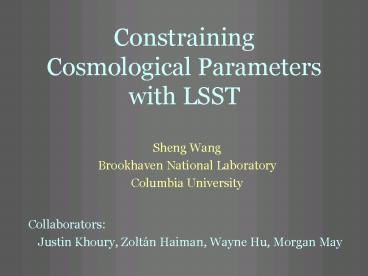Constraining Cosmological Parameters with LSST PowerPoint PPT Presentation
1 / 20
Title: Constraining Cosmological Parameters with LSST
1
ConstrainingCosmological Parameterswith LSST
Sheng Wang Brookhaven National Laboratory Columbia
University
Collaborators Justin Khoury, Zoltán Haiman,
Wayne Hu, Morgan May
2
Conclusion
1. Future galaxy cluster surveys will be able to
find many thousands of clusters. This cluster
sample will have statistically well-controlled
mass estimates and can place precise and robust
constraints on cosmological parameters. 2.
Combined with future CMB measurements, it is
possible to reach a sensitivity of at least ?(w0)
0.06, ?(wa) 0.15 and ?(m?) 0.04 eV with
200,000 clusters from LSST. 3. The redshift
distribution of cluster abundance (dN/dz), the
power spectrum of clusters (P(k)) and CMB
anisotropy (Cl) provide complementary information.
3
Future Galaxy Cluster Surveys
LSST (Large Synoptic Survey Telescope)
A proposed ground-based 8.4-meter telescope
detecting galaxy clusters by their weak lensing
signals. Sky coverage 18000 deg2, Number of
clusters 200,000 (0.1 lt z lt 1.4,
Mmin1013.7h-1Msun)
4
Selection Function
Shear Selected Sample
Hamana, Takada Yoshida (2004)
Noise is determined by the intrinsic ellipticity
dispersion and the total number of galaxies
within a smoothing aperture
se 0.3, ng 65 arcmin-2.
5
dN/dz peaks z 0.3
6
Purity and Completeness
Completeness (fraction of missing halos)
Efficiency (false detection rate)
Hamana, Takada Yoshida (2004)
7
Fiducial Cosmology
Concordance (?CDM) Model
Obh2 0.014, O?h2 0, Omh2 0.24, ODE
0.73, ns 1, s8 0.9, w0 -1, wa 0, t
0.17
consistent with recent measurements by WMAP (2003)
Evolution of Dark Energy Equation of State
Linder (2002)
8
Fisher Matrix Formalism
Redshift Distribution of Number of Galaxy Clusters
Holder et al. (2001)
Redshift - Space Power Spectrum
Hu Haiman (2003)
9
Future CMB Surveys
Planck Surveyor
Measurement of TT, EE and TE in three frequency
bands. Constraints from CMB (unlensed) alone
(1s)
e.g. Eisenstein, Hu Tegmark (1999)
Constraints from clusters will be complementary
to those from cosmic microwave background (CMB)
anisotropy measurement.
10
Constraints onEvolution of Dark Energy
WMAP SDSS (galaxy Lyman a) SN Ia (1s)
Seljak et al. (2004)
11
Result
LSST (As 18,000 deg2, Ntotal 200,000)
Constraints (by clusters) mainly from dN/dz
efficiency e 40, completeness c 60.
12
?(w0) 0.06, ?(wa) 0.15. (LSST Planck)
13
Constraints on Neutrino Mass
Atmospheric Neutrino Oscillation (Super-K)
Lower Bound
Ashie et al. (2003)
WMAP SDSS (galaxy Lyman a) SN Ia (1s)
WMAP SDSS galaxy (1s)
Seljak et al. (2004)
14
Result
LSST (As 18,000 deg2, Ntotal 200,000)
Constraints (by clusters) mainly from P(k)
efficiency e 40, completeness c 60.
15
?(S m?) 0.04 eV. (LSST Planck)
16
Conclusion
1. Future galaxy cluster surveys will be able to
find many thousands of clusters. This cluster
sample will have statistically well-controlled
mass estimates and can place precise and robust
constraints on cosmological parameters. 2.
Combined with future CMB measurements, it is
possible to reach a sensitivity of at least ?(w0)
0.06, ?(wa) 0.15 and ?(m?) 0.04 eV with
200,000 clusters from LSST. 3. The redshift
distribution of cluster abundance (dN/dz), the
power spectrum of clusters (P(k)) and CMB
anisotropy (Cl) provide complementary information.
17
END
18
Galaxy Cluster Abundance
Dependence on cosmological parameters
of clusters per unit area and z
comoving volume
mass limit
mass function
mass function
Jenkins et al. 2001
Hubble volume N-body simulations in three
cosmologies cf Press-Schechter
growth function
power spectrum (?8, M-r)
overall normalization
19
Cluster Power Spectrum
Dependence on cosmological parameters
Observable
transfer function
inverse volume
initial spectrum
cluster bias
growth function
redshift distortion
Radial modes
Hubble constant
Geometry! (w/ physical scale info)
Transverse modes
Angular diameter distance
Redshift distortion
Scales with growth function
20
(No Transcript)

